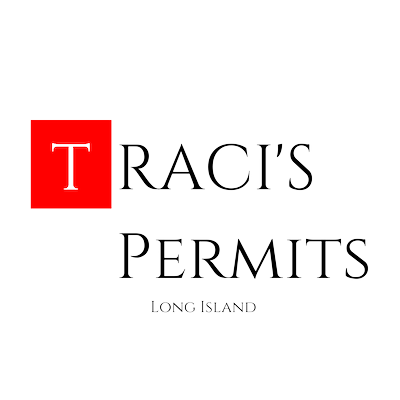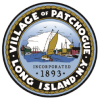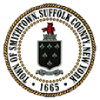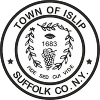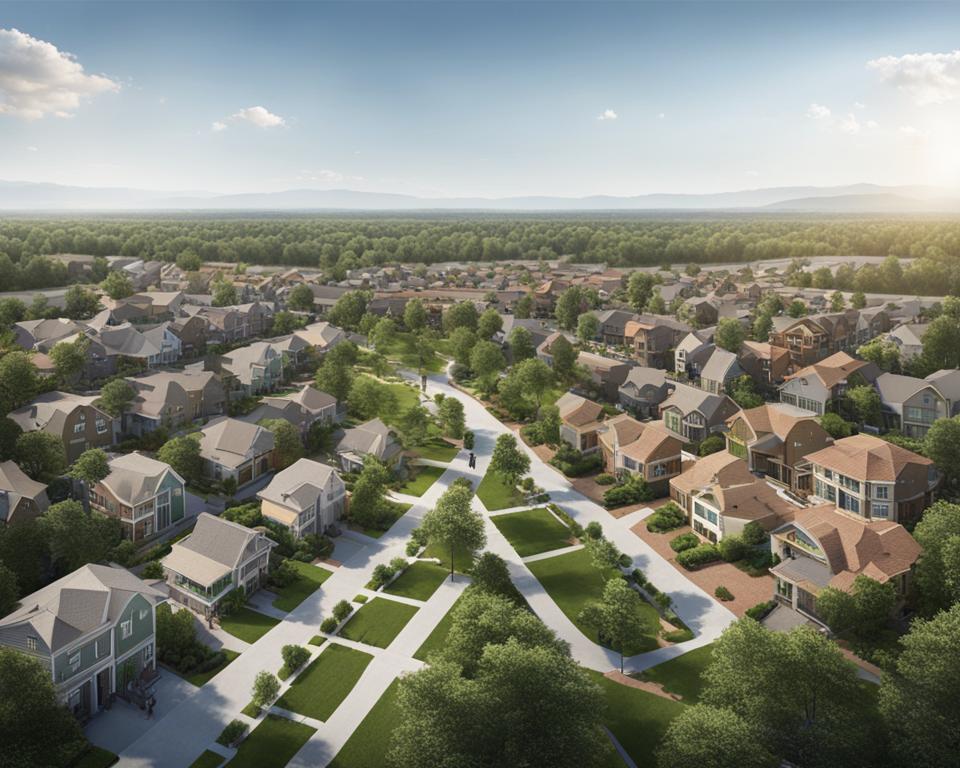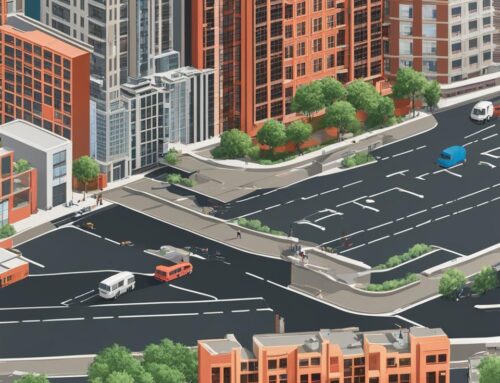Zoning variances can have both positive and negative impacts on communities. It is essential to understand the consequences of zoning variances and how to mitigate any potential negative effects. This guide will provide strategies and techniques for addressing zoning variance issues and reducing their drawbacks. By implementing effective mitigation measures, communities can ensure harmony and sustainable development.
At TracisPermits.com, we are Long Island’s top choice for zoning variances. With our expert guidance, seamless applications, and a high success rate in meeting local regulations in Suffolk County and Nassau County, we can help you navigate the complexities of zoning variance regulations. Call us at 631-492-0927 today!
Key Takeaways:
- Mitigating negative impacts of zoning variances is crucial for community development.
- Understanding zoning variance consequences and regulations is essential.
- Effective mitigation measures can ensure sustainable development.
- TracisPermits.com offers expert guidance and assistance with zoning variances in Suffolk County and Nassau County.
Stay tuned as we delve deeper into the various aspects of zoning variances and provide valuable insights in the upcoming sections of this guide.
Understanding Zoning Board of Appeals
The zoning board of appeals plays a crucial role in the zoning process, specifically in the granting of use and area variances and interpretations of zoning laws. To effectively navigate zoning variances and their potential negative impacts, it is essential to have a clear understanding of the powers and duties of the zoning board of appeals.
The zoning board of appeals is responsible for evaluating and deciding on requests for variances, which are exceptions to the existing zoning regulations. Their decisions involve a careful consideration of various factors, including:
- The impact of the proposed variance on the surrounding neighborhood
- Alternative methods to achieve the desired outcome
- The substantiality of the variance requested
- The potential adverse effects of the variance on the community
By assessing these factors, the zoning board of appeals aims to strike a balance between the needs and desires of the applicant and the effects on the community as a whole. It is through this evaluation process that they can mitigate any potential negative impacts of zoning variances.
Additionally, the zoning board of appeals holds the authority to interpret zoning laws in cases where ambiguity or disputes arise. Their interpretations help clarify zoning concepts and functions, ensuring a consistent understanding and application of the regulations.
Overall, understanding the role, powers, and duties of the zoning board of appeals is vital for effectively navigating zoning variances and mitigating any potential negative impacts on communities.
Types of Zoning Variances
When it comes to zoning variances, there are two main types to consider: use variances and area variances. Understanding the differences between them is important for navigating the complexities of zoning regulations.
Use Variances
Use variances allow for the use of land that is not permitted by the zoning regulations. This means that property owners can seek permission to use their land for purposes that deviate from the established zoning rules. Use variances are typically granted when the property owner can demonstrate that an alternative use would not yield a reasonable return and that there are unique circumstances that warrant the variance.
For example, if a property owner wants to convert a residential property into a small boutique, they would need to apply for a use variance since commercial use is not allowed in that specific zone.
Area Variances
Area variances, on the other hand, grant permission for the use of land that does not meet the dimensional or physical requirements set by the zoning regulations. This can include structures that exceed height limits, setback requirements, or lot coverage limits. Area variances are typically granted when the property owner can demonstrate that strict adherence to the regulations would result in an undesirable change in the neighborhood and that there are unique circumstances or self-created hardships that justify the variance.
For example, if a property owner wants to build an extension that slightly exceeds the height limit due to unique circumstances such as topography or pre-existing structures, they would need to apply for an area variance.
When considering variances, local zoning boards must carefully evaluate the reasonable return for the property owner, the unique circumstances of the property, and the potential undesirable changes in the neighborhood. This ensures a balanced approach that takes into account the needs of property owners while preserving the integrity and character of the community.
| Type of Variance | Description |
|---|---|
| Use Variances | Allow for the use of land that is not permitted by zoning regulations |
| Area Variances | Grant permission for the use of land that does not meet dimensional or physical requirements |
The Area Variance Standard
When granting an area variance, it is crucial for the zoning board of appeals to carefully consider the potential benefits to the applicant and weigh them against the possible detriments to the health, safety, and welfare of the community. Several key factors must be taken into account to ensure that the variance aligns with the community’s best interests.
Firstly, the board must evaluate whether the proposed variance would result in an undesirable change in the neighborhood. This includes considering the impact on the overall character and quality of the surrounding area. The goal should be to preserve the unique essence of the community and prevent adverse changes that may negatively affect property values or the general livability of the neighborhood.
The availability of alternative methods is another critical aspect to consider when assessing an area variance. The board should explore whether there are alternative approaches or design solutions that would achieve the applicant’s objectives without the need for a variance. By doing so, the community’s interests can be protected while still accommodating the applicant’s needs.
The substantiality of the variance is also a crucial consideration. The board must evaluate the scale and extent of the variance being requested in relation to the existing zoning regulations. A substantial variance may have more significant implications for the neighborhood and could potentially disrupt the overall harmony and character of the area. Therefore, it is essential to assess whether the magnitude of the variance is reasonable and justified.
Moreover, the physical and environmental conditions in the area must not be overlooked. The board should carefully examine how the proposed variance may impact these conditions. Factors such as traffic flow, noise pollution, open space, and environmental preservation should all be taken into account to ensure that the variance does not compromise the health and well-being of the community.
The ultimate goal is to grant the minimum necessary variance to achieve the desired outcome while safeguarding the interests of the community. By carefully considering the benefit to the applicant and weighing it against the potential detriment to the community, the zoning board of appeals can make informed decisions that strike a balance between individual needs and the welfare of the neighborhood.
| Factors to Consider for an Area Variance | Description |
|---|---|
| Undesirable Change in Neighborhood | Evaluate the impact on the character and quality of the neighborhood. |
| Availability of Alternative Methods | Explore potential alternative approaches or design solutions that would eliminate the need for a variance. |
| Substantiality of the Variance | Assess the scale and extent of the variance in relation to existing zoning regulations. |
| Physical and Environmental Conditions | Examine the potential impact on traffic, noise, open space, and environmental preservation. |
The Use Variance Standard
Use variances require a different set of criteria to be considered. The reasonable return for the property owner, unique circumstances surrounding the property, self-created hardship, and the essential character of the neighborhood are all factors that influence the decision to grant a use variance. While use variances may be more difficult to obtain, it is still important to mitigate any potential negative impacts they may have on the community.
Evidence and Public Participation
In zoning board of appeals proceedings, the decision-making process is considered quasi-judicial. Although formal rules of evidence may not apply, the board must base its decision on the evidence presented in the record. This evidence includes expert testimonies, plans, photographs, and statements from the public.
Public participation plays a crucial role in zoning board proceedings. Members of the community are encouraged to voice their opinions and concerns. However, it is important to note that community opposition alone should not be the sole basis for denying a variance. The board must consider and weigh all evidence presented, ensuring a fair and thorough evaluation of the case.
Expert Testimonies and Plans
Expert testimonies are considered valuable evidence in zoning board proceedings. These testimonies provide insights and professional opinions regarding the impact of a proposed zoning variance on the community and surrounding areas. Expert opinions help the board make informed decisions based on technical and specialized knowledge.
Plans, including architectural designs and site layouts, offer visual evidence to support or challenge the need for a zoning variance. These plans provide a clear understanding of the project’s scope and its potential effects on the neighborhood, ensuring a comprehensive evaluation by the board.
Photographs and Community Statements
Photographs can be powerful visual evidence in zoning board proceedings. They showcase the existing conditions and surroundings, giving the board a better understanding of the potential visual impact of the proposed variance. Photographs help the board evaluate the compatibility of the project with the neighborhood’s character.
Statements from the public are an essential part of public participation in zoning board proceedings. They allow community members to express their opinions, concerns, and support concerning the proposed variance. While public sentiment is valuable, the board must consider the statements within the context of the evidence presented and the applicable zoning regulations.
Public participation and evidence-based decision-making are crucial in zoning board proceedings. By considering expert testimonies, plans, photographs, and community statements, the board can make informed decisions that balance the needs of the community with the potential impacts of the proposed variance.
Procedure and Decision-Making Process
The procedure for zoning board of appeals hearings involves several key steps that ensure a fair and informed decision-making process. These steps include proper notice, the conduct of the hearing, consideration of evidence, and the documentation of the decision in a zoning board resolution.
Proper Notice and Conduct of the Hearing
Before a zoning board of appeals hearing takes place, it is important to provide proper notice to all parties involved. This includes notifying property owners within a certain radius of the property in question, as well as publishing the notice in local newspapers or other designated publications.
During the hearing, the board must conduct the proceedings in a fair and impartial manner. This includes giving all parties the opportunity to present their arguments and evidence, as well as allowing for public participation through testimony or written submissions. The board should also ensure that all relevant documents and materials are available for review and consideration.
Consideration of Evidence
The zoning board of appeals should carefully consider all the evidence presented during the hearing. This may include expert testimonies, plans, photographs, and statements from the public. Each piece of evidence should be evaluated based on its relevance, credibility, and significance in relation to the case at hand.
“The board must base its decision on the evidence presented in the record.”
During the evaluation process, the board should use its expertise to assess the implications of the evidence and how it aligns with the relevant zoning regulations and guidelines. It is important to weigh the potential impacts on the neighborhood, alternative methods to achieve the desired outcome, and any potential adverse effects on the community’s well-being.
Zoning Board Resolution
After careful consideration of the evidence, the zoning board of appeals should make a decision that is supported by facts and reasons. This decision should be documented in a written resolution that clearly addresses each factor and the overall balancing test. The resolution should include a comprehensive analysis of the evidence, an explanation of how the board arrived at its decision, and the specific conditions or requirements that may be imposed on the granted variance.
By following a well-defined procedure and making decisions based on thorough consideration of the evidence, the zoning board of appeals can ensure a fair and consistent decision-making process. This promotes transparency and accountability while mitigating the negative impacts of zoning variances on communities.
Referral to Planning Agencies and Environmental Review
When it comes to zoning variances, sometimes it is necessary to seek the expertise and guidance of planning agencies or conduct an environmental review. These additional steps ensure that all applications are thoroughly evaluated and comply with relevant local and state regulations. By involving planning agencies and conducting environmental reviews, communities can make well-informed decisions and mitigate potential impacts on the environment and surrounding areas.
In certain cases, the complexity and potential consequences of zoning variances require external input. Planning agencies have the expertise and knowledge to assess the proposed variances and provide valuable recommendations based on their understanding of zoning regulations and community development plans. Their insights help ensure that any changes or exceptions made through zoning variances align with the long-term goals of the community.
Furthermore, an environmental review is essential to assess any potential environmental impact associated with the requested variances. This review evaluates factors such as air quality, water resources, wildlife habitats, and overall ecological balance. By carefully considering these aspects, communities can make informed decisions that prioritize sustainability and protect their natural surroundings.
Referring applications to planning agencies and conducting environmental reviews also demonstrate transparency and accountability in the decision-making process. It helps build trust within the community, as the opinions and expertise of multiple stakeholders are taken into account. This collaborative approach ensures that all potential impacts and considerations are thoroughly evaluated, leading to a more holistic and balanced decision-making process.
Benefits of Referral to Planning Agencies and Environmental Review:
- Expert recommendations from planning agencies informed by zoning regulations and community development plans
- Evaluation of potential environmental impacts to protect natural resources and promote sustainability
- Transparency and accountability in decision-making process
- Inclusion of diverse perspectives and expertise
- Enhanced community trust and confidence in the variance approval process
The referral to planning agencies and conducting an environmental review is a crucial step in ensuring that zoning variances align with the overall vision and goals of a community. By considering expert recommendations and evaluating potential impacts, communities can make informed decisions that lead to responsible and sustainable development.
Judicial Review and Deference to Board Decisions
Once the zoning board of appeals has made a decision on a zoning variance application, it is subject to judicial review. Judicial review is the process by which a court reviews the decision of a administrative body to determine if it was made in accordance with the law.
Courts generally defer to the decisions of the zoning board of appeals, recognizing that the board possesses the expertise and local knowledge to make informed decisions. However, courts will intervene if the board’s decision is found to be illegal, arbitrary, or an abuse of discretion.
In order to withstand judicial scrutiny, the board’s findings and reasoning must be clearly stated. The board should provide a thorough analysis of the evidence presented during the proceedings and explain how it led to their decision. By demonstrating a well-reasoned decision-making process, the board increases the likelihood that its decision will be upheld.
It is crucial for the zoning board of appeals to make decisions that are supported by the evidence presented. Arbitrary or capricious actions can undermine the board’s credibility and increase the risk of judicial intervention.
“The role of the court is not to substitute its judgment for that of the board, but rather to ensure that the board’s decision is consistent with the relevant laws and regulations.”
Example: Zoning Board of Appeals Decision
| Factors Considered | Board Decision | Explanation |
|---|---|---|
| Impact on neighborhood | Approved | The proposed variance had a minimal impact on the surrounding neighborhood. |
| Alternative methods | Denied | The applicant failed to demonstrate that there were no feasible alternative methods to achieve the desired outcome. |
| Substantiality of the variance | Approved | The variance was deemed substantial, but the benefits outweighed the detriments to the community. |
| Effects on physical and environmental conditions | Approved | The board concluded that the proposed variance would not have adverse effects on the physical and environmental conditions of the area. |
By considering relevant factors, providing a clear explanation for their decision, and making decisions supported by evidence, the zoning board of appeals can increase the likelihood of their decisions being upheld during judicial review.
Case Study: Mitigating Negative Impacts of Zoning Variances in Suffolk County
Suffolk County has taken significant steps to mitigate the negative impacts of zoning variances and ensure sustainable development while maintaining community harmony. By implementing effective zoning variance mitigation techniques, the county has successfully addressed the implications of these variances.
One of the key strategies employed by Suffolk County is through community engagement and collaborative decision-making. The county actively involves residents, businesses, and stakeholders in the zoning variance review process, seeking input and feedback to understand the potential community impacts. This inclusive approach ensures that the decisions made regarding zoning variances reflect the needs and concerns of the local community.
“By actively involving all stakeholders in the zoning variance review process, Suffolk County has been able to address potential community impacts and find innovative solutions that balance the needs of property owners with the goals of the community.”
In addition to community engagement, Suffolk County emphasizes the importance of comprehensive planning. The county has implemented a robust zoning variance regulations framework, which provides clear guidelines for evaluating variances and promotes responsible community development. These regulations help in minimizing any undesirable changes that zoning variances could bring to the neighborhoods.
As part of their mitigation efforts, Suffolk County places a strong emphasis on considering the long-term impacts of zoning variances. They prioritize the evaluation of potential environmental, social, and economic consequences to ensure sustainable development within the community. This forward-thinking approach allows the county to make informed decisions that mitigate negative impacts and promote the well-being of the residents.
Evidence of Success
Suffolk County’s mitigation efforts have yielded positive outcomes, with tangible results in reducing the adverse effects of zoning variances. The county has experienced improved community cohesion, reduced conflicts, and enhanced livability as a direct result of their mitigation initiatives.
Examples of specific strategies and initiatives undertaken by Suffolk County include:
- Establishment of design guidelines to maintain the character and integrity of neighborhoods affected by zoning variances.
- Investment in infrastructure and public amenities to mitigate any additional strain caused by zoning variances.
- Promotion of sustainable development practices, such as incorporating green spaces and energy-efficient designs in variances.
- Collaboration with local businesses and organizations to address any potential economic impacts of variances and foster positive community growth.
The success of these initiatives showcases Suffolk County’s commitment to responsible planning and an unwavering dedication to mitigating the negative impacts of zoning variances.
| Benefits of Suffolk County’s Zoning Variance Mitigation | Community Impacts |
|---|---|
| Enhanced community cohesion and harmony | Reduced conflicts and disputes |
| Maintained neighborhood character and aesthetics | Improved quality of life for residents |
| Promoted sustainable and eco-friendly development | Minimized environmental impacts |
| Positive economic growth and investment opportunities | Support for local businesses |
Case Study: Mitigating Negative Impacts of Zoning Variances in Nassau County
In this section, we will examine a case study that focuses on Nassau County and its successful approach to mitigating the negative impacts of zoning variances. Nassau County has implemented comprehensive zoning variance regulations and guidelines to promote responsible and well-planned community development. Through specific initiatives and programs, Nassau County has effectively reduced the adverse consequences of zoning variances, ensuring a harmonious and sustainable environment for its residents.
Nassau County’s zoning variance regulations prioritize community development by striking the balance between meeting the needs of property owners and preserving the character of the neighborhoods. By adhering to these regulations, Nassau County ensures that variances granted align with the overall vision for responsible and planned growth.
The county has established clear criteria for granting variances, considering aspects such as the impact on the neighborhood, potential adverse effects on the community, and the uniqueness of the circumstances. These criteria help evaluate the necessity and feasibility of the requested variances, ensuring that only suitable and justifiable variances are granted.
Nassau County actively encourages public participation in the zoning variance process. The input and concerns of the community play a crucial role in the decision-making process, providing valuable insights that contribute to responsible and well-informed decisions. This commitment to public engagement fosters transparency, trust, and community involvement.
One notable initiative in Nassau County is the Nassau County Council on Community Development (NCCCD), which works closely with local communities to address zoning variance issues. The NCCCD provides guidance, resources, and support to residents, property owners, and local organizations, ensuring that zoning variance applications are in line with the county’s development goals and regulations.
This case study demonstrates how Nassau County’s comprehensive zoning variance regulations, emphasis on community development, and collaborative approach have successfully minimized the negative impacts of zoning variances. The county’s commitment to responsible growth and community engagement serves as a model for other regions grappling with similar challenges.
| Key Initiatives in Nassau County: | Impact: |
|---|---|
| Clear and comprehensive zoning variance regulations and guidelines | Ensures responsible and well-planned community development |
| Evaluation criteria for granting variances | Ensures variances align with the overall vision for growth |
| Active public participation | Fosters transparency, trust, and community involvement |
| Nassau County Council on Community Development (NCCCD) | Guidance and support to address zoning variance issues |
Quote from a Nassau County Resident
“Nassau County’s approach to zoning variances has brought a sense of stability and community harmony. The regulations and initiatives in place ensure that growth is responsible and considerate of the neighborhood’s character. Our voices as residents are heard, and it’s reassuring to know that our concerns and feedback truly matter in the decision-making process.”
Conclusion
Effectively mitigating the negative impacts of zoning variances requires careful consideration of the unique circumstances, community needs, and available resources. By implementing the strategies and techniques outlined in this guide, communities can address zoning variance issues and minimize their drawbacks.
Proper planning and mitigation efforts are essential to achieve community harmony and sustainable development in the face of zoning variances. The importance of engaging with experts like TracisPermits.com cannot be overstated. As Long Island’s top choice for zoning variances, TracisPermits.com offers expert guidance, seamless applications, and a high success rate in meeting local regulations in both Suffolk County and Nassau County.
For assistance in navigating the complex world of zoning variances and ensuring compliance with local regulations, reach out to TracisPermits.com at 631-492-0927 Today!
FAQ
What are zoning variances?
Zoning variances are permissions granted by the zoning board of appeals that allow for land use or physical requirements that deviate from the existing zoning regulations.
What are the consequences of zoning variances?
Zoning variances can have both positive and negative impacts on communities. The negative consequences may include undesirable changes in the neighborhood, adverse effects on the community’s health, safety, and welfare, and potential self-created hardships.
What are the strategies to mitigate the negative impacts of zoning variances?
Strategies to mitigate the negative impacts of zoning variances include considering alternative methods, weighing the benefit to the applicant against the detriment to the community, granting the minimum variance necessary, and preserving the character of the neighborhood.
What is the role of the zoning board of appeals in mitigating negative impacts?
The zoning board of appeals plays a critical role in mitigating negative impacts by carefully considering factors such as the impact on the neighborhood, alternative methods to achieve the desired outcome, and the potential adverse effects on the community before granting variances.
What are the criteria for granting area variances?
When considering area variances, the zoning board of appeals must weigh the benefit to the applicant against the detriment to the health, safety, and welfare of the community. Factors such as the creation of an undesirable change in the neighborhood, the availability of alternative methods, and the substantiality of the variance are considered.
What factors are considered when granting use variances?
Use variances require considering factors such as the reasonable return for the property owner, unique circumstances surrounding the property, self-created hardships, and the essential character of the neighborhood.
What is the procedure for zoning board of appeals hearings?
The procedure includes proper notice, conducting hearings, considering evidence, and the decision-making process. The board must follow a timeline, notify all parties involved, consider evidence, and document decisions in a written resolution.
How are zoning board of appeals decisions reviewed?
Zoning board of appeals decisions are subject to judicial review. Courts generally defer to the decisions of the board unless they are illegal, arbitrary, or an abuse of discretion.
What are the case studies on zoning variance mitigation in Suffolk County and Nassau County?
The case studies highlight successful mitigation techniques and initiatives implemented by Suffolk County and Nassau County to address the negative impacts of zoning variances and promote responsible community development.
What are some zoning variance mitigation techniques?
Zoning variance mitigation techniques include careful consideration of circumstances, community needs, and available resources, effective planning, community participation, and adherence to local and state regulations.
